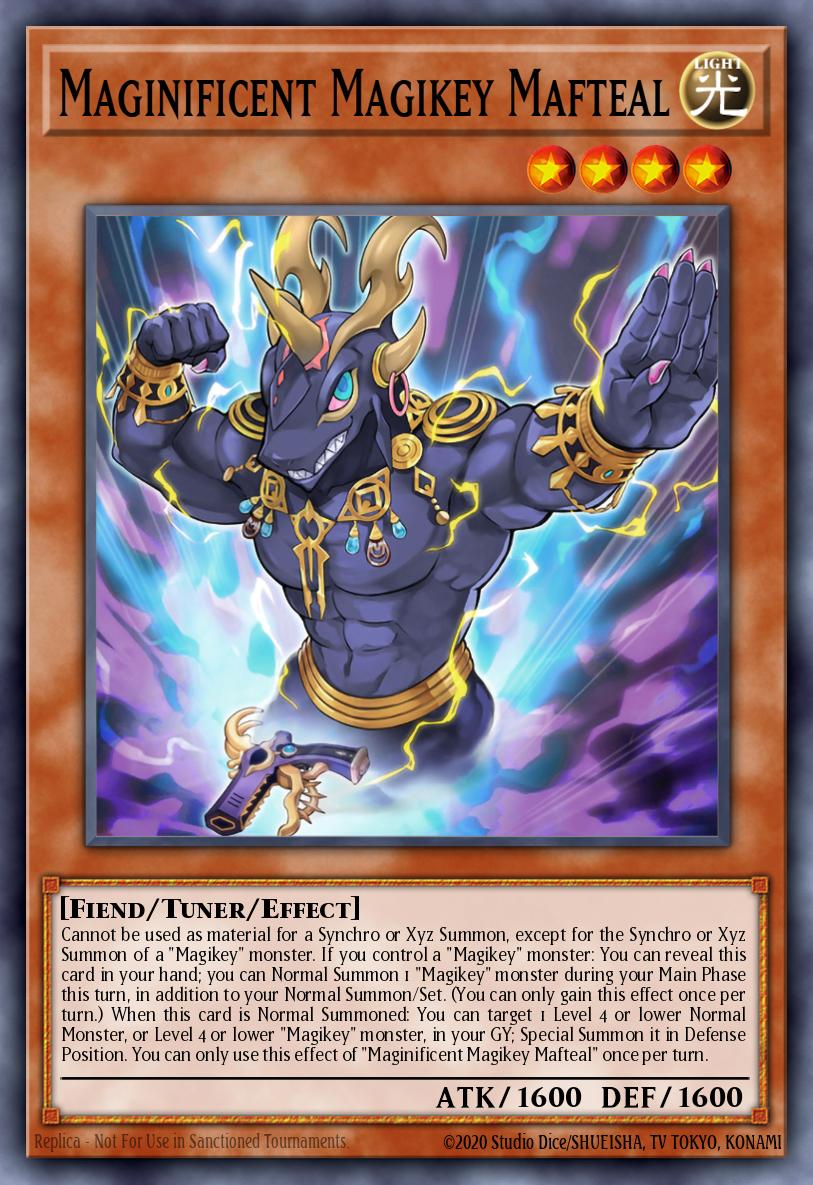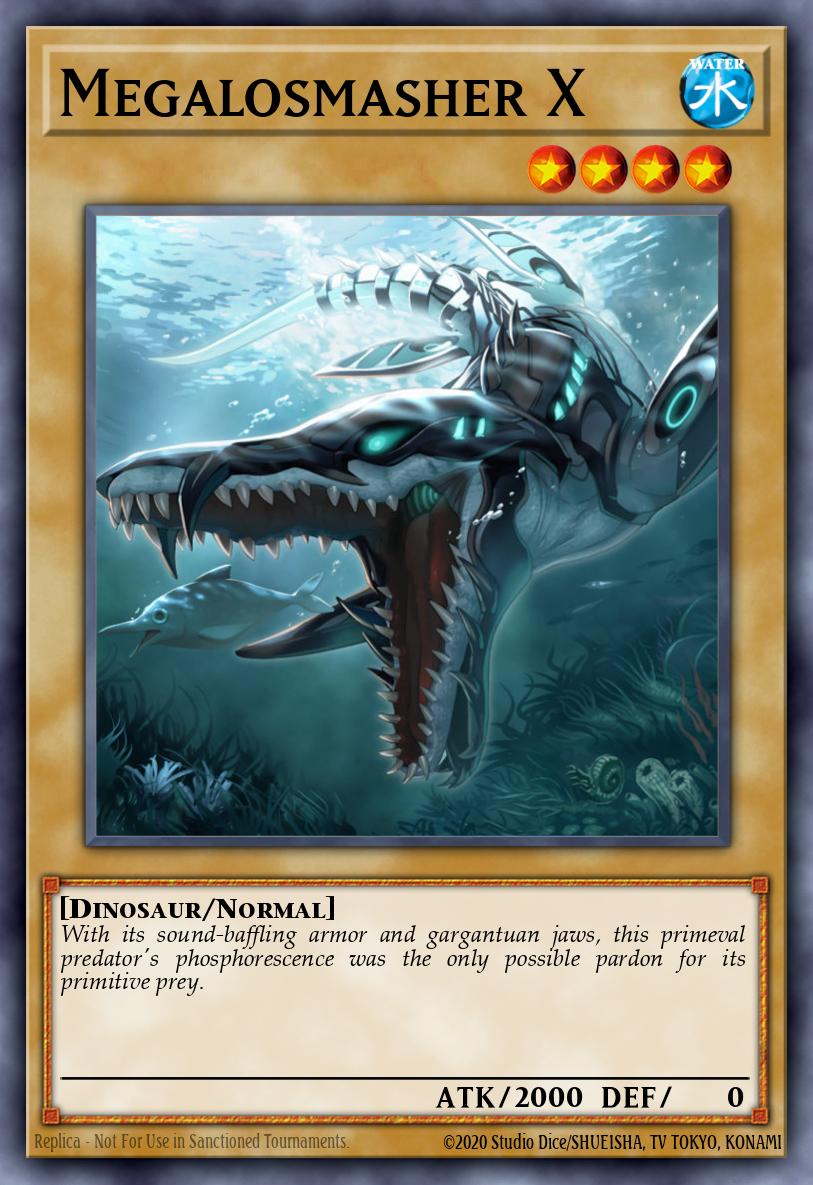Overview
As I've written in a previous article, Rituals have gone through a great transformation recently. Impcantations made them playable, Megaliths made them good, and Drytrons made them meta for the first time since Nekroz format. When the Magikey archetype was first revealed, I had hoped that it would be the next stage in a series of constant Ritual evolution. However, upon closer inspection, I realized that this conception of Magikey was wrong for two key reasons.
There's good news and bad news. The bad news is that Magikey doesn't feel nearly as strong as Drytron, marking a detour in Ritual's recent rise. But the more positive assessment is that Magikey was never a successor to the Ritual Revolution at all. Instead, it's much more than that. Magikey innovates not only Ritual, but also Fusion, Synchro, Xyz, and even Links. With time, that innovation may even prove to be competitive; but for now, it's at least unique and fun.
Monsters


There are only two Main Deck monsters in this archetype, and one of them is a Normal Monster. The high stats of Clavis, the Magikey Skyblaster make him a nice beater, but he's usually just material for bigger monsters. Greater Magikey - Mafteahl is an interesting extender. Instead of Special Summoning itself, it grants you an extra Normal Summon (of itself) if you control another Magikey. And once it appears, it can even revive not just Clavis, but any Normal Monster.





That's a theme that will become more apparent as more cards show up. Magikey gains certain benefits from using Normal Monsters as materials. It particularly wants to get Normal Monsters with different attributes in the graveyard. The Magikey boss monsters are Levels 4 and 8, so of course you'll want monsters that you can Normal Summon and use as material. And since you don't have to think about effects, you might as well pick the ones with the biggest numbers. A possible exception could be Angel Trumpeter, who is a Tuner as well and could enable your plays that way.
Spells



The Spells, and particularly Magikey - Maphteah, are where Magikey's creative design really begins to show. Maphteah is both a Ritual and Fusion Spell at once. When activated, the user can choose either summoning method and bring out a corresponding monster. It can tribute or fuse from the deck under the right conditions. It's not even once per turn. This card makes the deck compact and flexible. Other decks use separate Ritual and Fusion Spells to bring out different monsters, making deckbuilding clunky. With one card "unlocking" both methods, deckbuilding gets much easier, and bricking is less of a problem. When you take your first turn, Maphteah lets you evaluate your hand and your opponent's field, before choosing what to summon.
However, this design comes at a cost. Since Maphteah isn't actually a Ritual Spell (or even a "Polymerization" or "Fusion" card), it can't benefit from cards that specifically search those spells. Manju of the Ten Thousand Hands and Herald of the Arc Light can find the monsters, but not this spell. Nor can something like Predaplant Verte Anaconda cheat it out. In doing two things at once, Magikey loses out on great support for both.
Fortunately, the archetype has ways to address that problem. One of them is Magikey World, a Field Spell that searches a Magikey monster on summon, and Maphteah in exchange for another card. Searching both a monster and the key spell makes World a great one-card starter. It even has once-per-turn destruction protection for Normal Monsters. Speaking of Protection, Magikey Battle can recycle used cards while protecting monsters from adverse effects. However, unlike a card like Crusadia Power, Battle has to be chained to that effect to get the protection. This makes it a bit inflexible to use, especially if the opponent uses backrow outs first.
Traps



Magikey Duo and Magikey Lock - Lock don't see too much use. A Quick Effect Fusion or Ritual can be a neat gimmick, but it's too slow. And there are better cards to use - namely, Magikey Unlocking. A Counter Trap that negates a Spell or Trap is much more threatening on a first-turn board. Also, it changes the opponent's monsters to an attribute of your choice. This effect synergizes well with the effects of the Magikey bosses. Speaking of which...
Extra Deck*






*The term is used loosely to include the Rituals.
These monsters are the whole goal of the archetype. Some of them are used to enable combos. Some of them set up defenses going first. And some of them wreak havoc going second.
Magikey Mechmusket - Batosbuster is "key" for setting up combos. It searches any Magikey card, including the Field Spell, and is a Level 4 Tuner that can make any of the other bosses. It can also negate an opposing monster's effects while fixing your hand. Magikey Beast - Ansyalabolas is a similar card. Instead of searching the deck, it brings Magikey - Maphteah back for a second use. It is also a Level 4 Tuner, and it can weaken opposing monsters and banish them in battle. Both of these cards have nice effects and useful stats that can allow you to extend your plays.
Magikey-Possessed Spirit - Weparthu's first effect doesn't stand out. Adding a Normal Monster to hand, even Clavis, is only useful in specific scenarios. This is especially true because you probably already Normal Summoned to make Weparthu. You could have made something like Batosbuster and searched more useful cards. But the second effect is much more interesting. It can banish any monster it battles with, as long as that monster shares an attribute with a Normal Monster or "Magikey" in your graveyard. This is where the attributes of your Normal Monsters starts to become relevant. If you have a matching monster, there are a lot of monsters you can out with this card. For example, assuming you've baited out Red-Eyes Dark Dragoon's negate, even that card will fall to Weparthu.
Magikey Dragon - Andrabime has an effect with a wider range. It can destroy all monsters your opponent controls with the attribute of one of your monsters in the graveyard. If you match a vanilla to your opponent's mono-attribute deck, or if you've used Magikey Unlocking, you could potentially wipe your opponent's board. Andrabime will even give you an extra draw if you destroy a monster with an attribute matching a monster in your grave.
In my opinion, Magikey Mechmortar - Garesglasser and Magikey-Mutated Ogre - Transfurmine are the strongest cards of this archetype. Garesglasser gets quite large when its ATK is boosted by your multiple attributes in grave. But more importantly, it can negate the effect of a monster with the same attribute as one in your grave, and destroy that monster. Even if this card gets outed, it can get you back another Magikey card for next turn. That's quite a dangerous effect on a turn 1 board. Having six attributes in grave is ideal (and possible), but a smart meta call can let you sit on Garesglasser with only two or even one attribute that covers a wide range of decks.
What could be better than a monster negate? How about a Slifer-like floodgate effect and a Spell/Trap negate in one? If you make Magikey-Mutated Ogre - Transfurmine with materials with different attributes, you can set a Magikey Spell or Trap from the Deck. You could get an extender like Maphteah, or tech out Unlocking for your turn 1 board. Once per turn, Transfurmine will also destroy an opponent's summoned monster that matches an attribute in your graveyard. Making this card alone can be annoying for some decks to get around. And when your turn comes to attack, Transfurmine can attack monsters twice, turning the tide in your favor.
Pros and Cons
Magikey has a really nice aesthetic. It's similar to Invoked in that one magic-user commands many beasts and many elements, but with its own magic-punk vibe. The mechanics are also quite interesting; the uniqueness of a Ritual-Spell card bears repeating. Tuner Rituals and Fusions are also hardly explored. The deck seems to be keen on uniting the summoning methods, having them work in harmony instead of being disparate engines. It's not just a Ritual deck; it embraces many styles at once. And using Normal Monsters and Attributes to fuel effects isn't something you see too often anymore.
That said, this creative design also leaves too many holes in the deck. Again, Maphteah is hard to search without the Field Spell. Using Normal Monsters is quaint, but it feels bad to draw a full hand of them, or to topdeck one when you need an out. And having effects dependent on matching attributes to the opponent's monsters doesn't work if you can't get the right attributes. In short, the creative style of the deck often gets in the way of its functional substance.
Magikey as it stands now is a bit too shaky to be a deck on its own, but it's too cool to not try and make it work. In the next article, I'll go further in detail on possible deckbuilding and the generic cards that can accompany the archetype.




